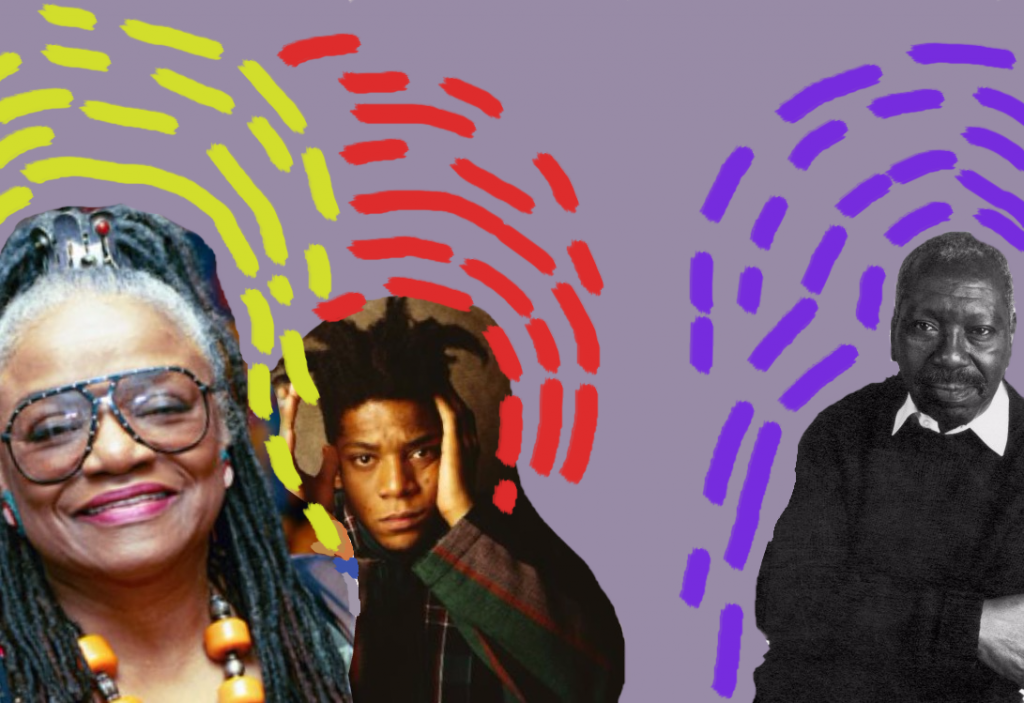February commemorated Black History Month– an annual celebration of influential African-American figures, culture, and milestones. Black artists have contributed to America’s ever changing artistic identity and style. What truly encompasses American art is its broad range of themes and diverse community of creators. The African-American voice is heard through its artists and their artwork, and has shaped a generation that continues to promote self-expression through creativity.
Jean-Michel Basquiat was a Brooklyn based artist of Puerto Rican and Haitian descent. Basquiat began his career with street art in the late 1970s, but soon expanded to groundbreaking modern art in the 1980s that addressed not only the racial themes of being a black person in the US, but overarching ideas about social dichotomies in other regards, such as colonialism and poverty. A young protege of Andy Warhol, Basquiat never shied away from grotesque portrayals of race and street life. In one of his more famous pieces Hollywood Africans, Basquiat confronts racial stereotypes about the typecasting of African Americans in the film industry. In another, entitled Six Crimee, Basquiat depicts six black figures with halos, along with aggressive writing of both numbers and symbols. He possessed a unique style of abstraction and symbols that is virtually unparalleled by any modern artist. Basquiat succeeded in bringing street art into the mainstream art world. Although he died of a heroin overdose at the age of 27, ramifications of his work have since reverberated through modern art.
Born and raised in New York City’s Harlem, Faith Ringgold grew up in a creative household: her mother a seamstress, and her father a storyteller. Ringgold used her artistry as a platform to voice her opinion on civil rights. This was most reflective in her well-known collection, the American People Series. Across twenty canvases, Ringgold illustrated her perspective on the Civil Rights and Black is Beautiful movements, using bright patriotic colors and occasionally graphic portrayals. Ringgold later expanded her mediums to create what she became most known for: her story quilts. In her first quilt, Who’s Afraid of Aunt Jemima?, Ringgold addresses the issue of racial and gender inequality through beautifully crafted hand-sewn images of men and women along with written narratives on the quilt. In another, titled Tar Beach, a young African American girl is flying over the George Washington Bridge on a summer night above Harlem, which is meant to symbolize liberation and independence during a time of racial divide within America. Ringgold continues to make an everlasting effect in the art industry. Not only does she confront significant issues through her work, but she also works to expose younger audiences to art, publishing several children’s books based off of her renowned quilts.
Jacob Lawrence was raised in Harlem after its intellectual, artistic, and cultural movement: the Harlem Renaissance. Here, Lawrence developed his signature modernist art style. At the age of 24, Lawrence became the first black artist to be represented by a New York gallery. Showing at New York’s Downtown Gallery in 1941, Lawrence’s The Migration Series made him one of the most significant artists of the 20th century. Illustrating scenes of the Great Migration over 60 panels, Lawrence brought attention to one of the greatest events in America’s history. Afterwards, Lawrence would continue to depict African-American life in his paintings, using bright colors, patterns, and shapes in works such as, The Builders and They Were Very Poor. Even after his passing in 2000 at the age of 82, Lawrence’s legacy continues to live on through his paintings of the Black-American experience, which are still widely recognizable today.
Throughout history, African-American culture has grown and evolved to envelop many different styles of art. Whether it be a painting from deep within the conflict of civil rights, or a more abstract piece depicting class struggle, this art has become a staple of United States History. Black History Month is a crucial time to remember all of the stylistic strides made by the black community throughout the history of American art.
Heather Loo and Violet Maxwell
staff writers
Graphics: Jessica Chang

